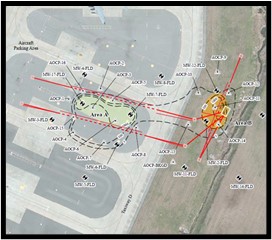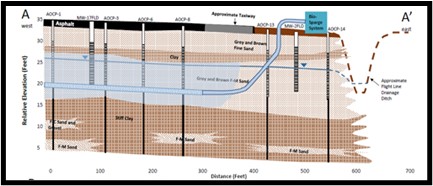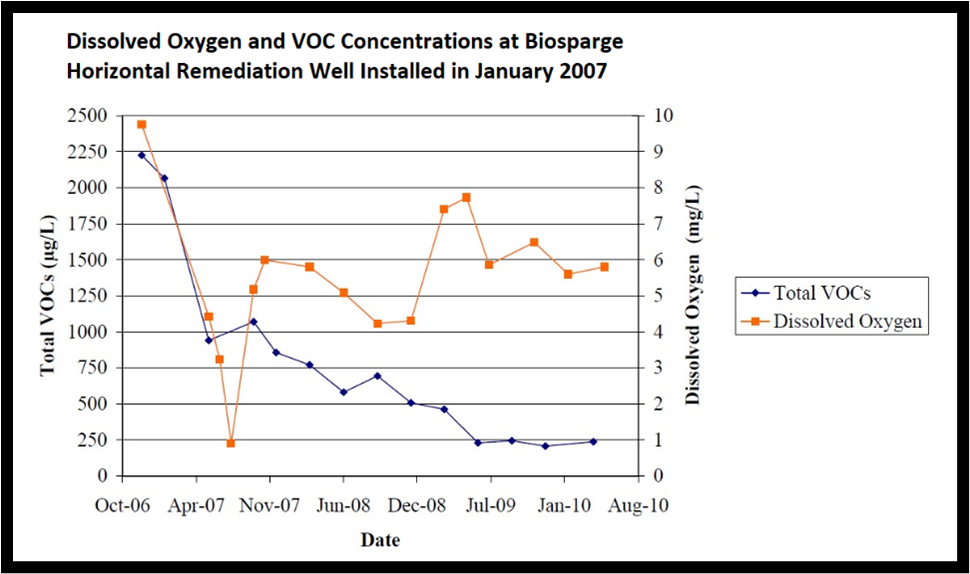Background and Setting
How is it that a consultant could use just 6 horizontal remediation wells to outperform 50 conventional remediation wells, and finally manage to bring closure to a stubborn project site? At an airfield site located in the southeastern United States, a large jet fuel release was caused by a leaking pipeline located along a flight line ditch. The plume width was measured to be approximately 200 feet with large sections of the plume extending underneath the aircraft runway. The site was underlain by estuarine deposits with a shallow groundwater table. Previous remediation systems had been operating at the site for over 6 years and included 8 recovery trench wells and 42 vertical air sparge/soil vapor recovery (AS/SVE) wells. The consultant had been tasked with coming up with a remediation plan that would bring the site to closure, but the large size and sensitive location of contaminant plume posed various difficulties.
Problem
The ongoing remediation efforts were deemed insufficient to close out the site and additional remedial efforts were going to be necessary in order to address the remaining contamination at the site. Not only did the consultant need to find a way to improve the previously installed remediation system, but they also needed to work with the airfield to limit interruptions to the aircraft traffic, which utilized the runway on a daily basis. Temporary shutdowns of the runway to install a grid of vertical wells were an intolerable option for the consultant’s client.
Solution
The consultant had prior experience working on challenging sites and called in a project partner with whom they had previously worked to achieve site closure on a similarly difficult project. Directional Technologies was brought in to help develop and install a horizontal remediation system that would provide the performance required to achieve site closure. The primary goals of the horizontal remediation system were to address the previously untreated contaminated areas located underneath the active runway, enhance remediation performance in areas that had been slow to remediate using traditional methods, and control the offsite migration of contaminated groundwater. Six horizontal biosparge wells were designed by Directional Technologies to address the remediation challenges.The wells were installed within a layer of dense grey-green clay containing discontinuous lenses of fine to medium sand. The horizontal remediation well systems were able to be installed and operated without causing any interruption to the airfield activities. As the biosparge wells were not required to be run concurrently, a mobile biosparging system was designed by the consultant to minimize O&M costs. The final horizontal system increased the total amount of screen in contact with the contaminated zone from the 210 feet of vertical screen previously installed to over 750 feet with the horizontal design, a 357% greater coverage.
Results
The final horizontal well design proved to be much more efficient than the previously installed system. Sampling data indicated dissolved oxygen enhanced aerobic degradation of the petroleum constituents at monitoring locations located greater than 120 feet from the horizontal biosparge wells. In addition to effectively remediating the contaminant concentrations, data from performance monitoring wells located at the property boundary indicated that the biosparge wells were effectively serving as a barrier that was preventing the downgradient migration of the contaminant plume. Within three years of system operation, groundwater VOC concentrations at the various areas of concern had been reduced to below regulatory standards. After many years of remediation efforts using traditional methods, the incorporation of horizontal remediation wells finally allowed the consultant to achieve site closure.
Do your projects call for site closure under challenging circumstances? Call our horizontal remediation well experts at 1-877-788-4479 to discuss your current project needs.


